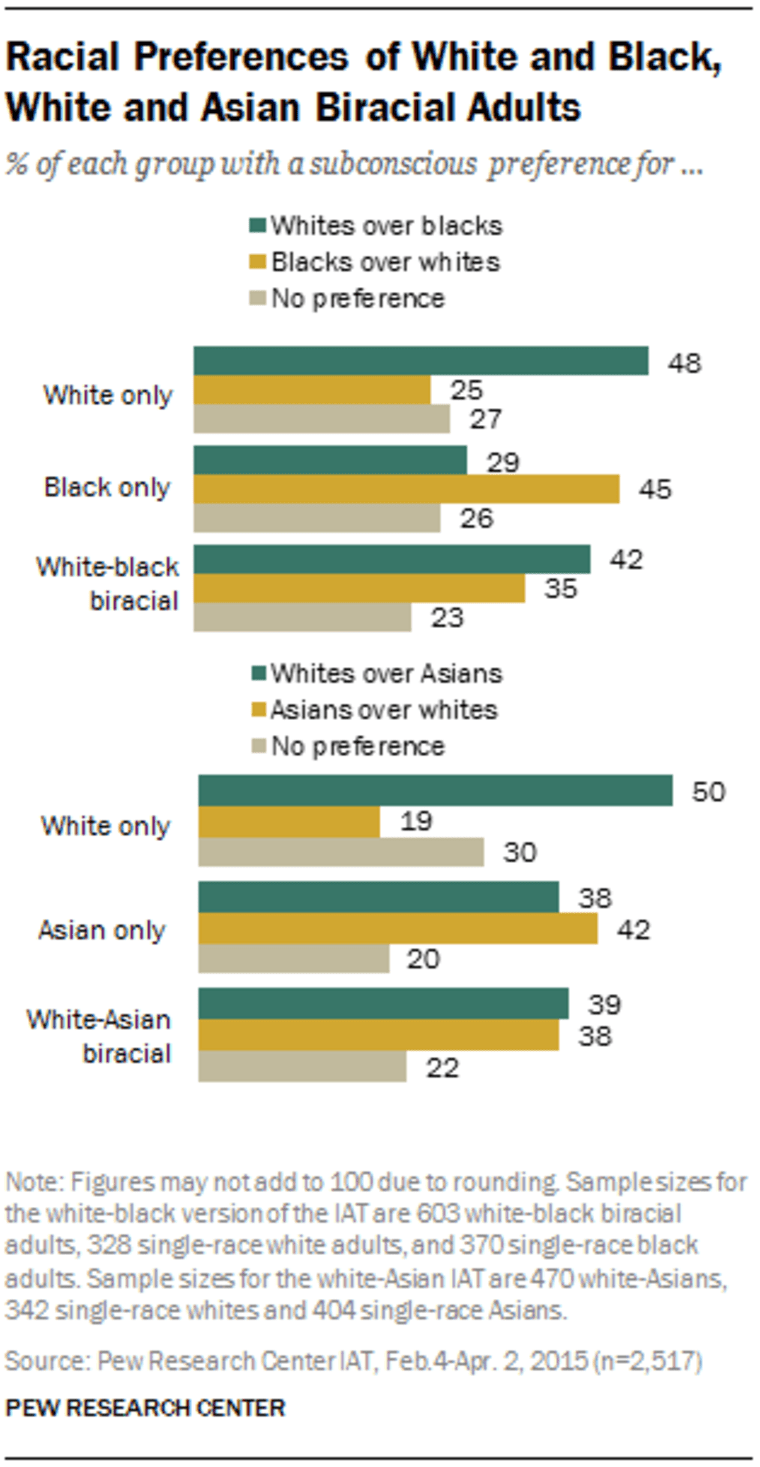A recent study from the Pew Research Center suggests that subconscious preferences for different racial groups persist, even among multiracial adults. Researchers at the Pew Research Center say that “most humans display a bias against out-groups—people who are different from them,” and a team of researchers wanted to find out whether biracial adults were less likely to have implicit racial biases because of their multicultural backgrounds. Pew says that the study’s findings suggest that biracial adults are “simply more divided in their racial preferences.”
Subconscious racial preferences can alter behavior, according to Pew. A 2007 study conducted by Harvard Medical School found that white doctors with high levels of implicit bias against blacks were less likely to treat black patients. A Swedish researcher found in 2010 that implicit bias against Muslims correlated strongly with the way hiring managers decided to interview either Swedes or Arabs for a position.
“Most of these implicit racial biases are consequence of subtle messages seen in the media, popular culture, that suggest one group is good, and another group is bad-- associating one group with crime, another group with accomplishment,” Rich Morin, senior editor at Pew, told NBC News.

The study utilized Implicit Association Tests (IAT) to reveal “hidden bias” among whites, blacks, Asian Americans, and biracial black-white and biracial Asian-white adults. The IAT measures how long it takes for a participant to associate positive or negative words with a given term or image. For example, when someone is prompted with a Caucasian face, if he selects the word “good” significantly more quickly than when the same person is prompted with an Asian American face, he may have an implicit bias in favor of whites. Pew conducted two experiments: one experiment took whites, blacks, and biracial black-white adults, and tested implicit bias among each group in favor of either whites or blacks. The other experiment took, whites, Asian Americans, and biracial Asian-white adults, and tested bias in favor of either whites or Asians.
Bias Among Biracials
In the study, more biracial Asian-white adults than monoracial whites had some form of implicit racial bias. Only 22% of Asian-white biracials were free of racial preference, whereas 30% of whites had no racial preference between whites and Asians. Fewer Asian-white biracials displayed implicit bias when compared to Asians. Only 20% of Asian Americans did not exhibit any subconscious racial preference.
Implicit bias among Asians in the study is notable because it challenges the in-group/out-group theory of bias. The study found only a 4% margin of difference between the percentage of monoracial Asians who favored Asians and the percentage of monoracial Asians who favored Whites - 38% of Asians favored whites over Asians, while 42% of Asians favored other Asians over whites.
White-black biracials had higher total rates of implicit bias than monoracial blacks and whites. Only 23% of white-black biracial adults did not have an implicit racial preference between blacks and whites, whereas 27% percent of monoracial white adults and 26% of monoracial black adults had no implicit preference.
Bias in Favor of Whites
The highest level of implicit racial preference revealed in the entire study was among whites being tested for bias against Asian Americans, with 50% of whites tested in the study revealing a subconscious preference for other whites over Asians. Thirty percent of whites had no implicit bias, and 19% of whites had a subconscious preference for Asians.
The second highest level of implicit racial preference was among whites tested for bias against blacks, with 48% of whites recorded as having a subconscious preference for other whites over blacks. Twenty-seven percent of whites tested had no preference between whites and blacks, and 25% of whites preferred blacks.
A higher percentage of biracial black-white adults and biracial Asian-white adults displayed implicit bias in favor of whites, when compared to bias in favor of their respective minority group.
Effect of Politics, Education, Age
The study suggests that the frequency and magnitude of racial bias does not significantly differ by age, education level, or political party. Republicans and Democrats hold similar levels of implicit bias, the study suggests. And contrary to some hypotheses that younger generations will no longer be racist, the age of survey respondents had no significant effect on levels of implicit bias. Although some previous Pew studies have shown that millennials are more racially tolerant than older generation, the IAT tests imply otherwise.
Stanford professor Shanto Iyengar, a consultant to the Pew study, said measuring implicit racial bias rather than explicit bias reveals a much higher frequency of prejudice. Morin wrote, “The IAT is useful in detecting views that individuals may be reluctant to divulge to others or even to admit to themselves.”
When asked how to dismantle these implicit biases, Morin told NBC News, “Simply knowing that you hold these biases is an important first step [in dismantling implicit bias]. It makes you think twice when making the hiring decision. That way, it keeps these biases in check.” Morin continued, “I do not know if it’s impossible to lose [biases], but it is certainly true from the literature that it’s possible to contain them … We aren’t race neutral but maybe we’re moving in that direction.”
Pew conducted this study from February to April this year and had a sample size of around 2500 respondents who were fielded from the British polling site YouGov. Rich Morin said to examine these results critically, given potential biases in sampling. He noted that those who took the test did so voluntarily and that the study did not include people without internet access. For the purposes of the study, the “Asian” category included people of East and Southeast Asian ancestry, such as Chinese, Koreans, Vietnamese, etc. The study did not include people of South Asian descent (Indian, Pakistani, Bangladeshi, Sri Lankans, etc.).